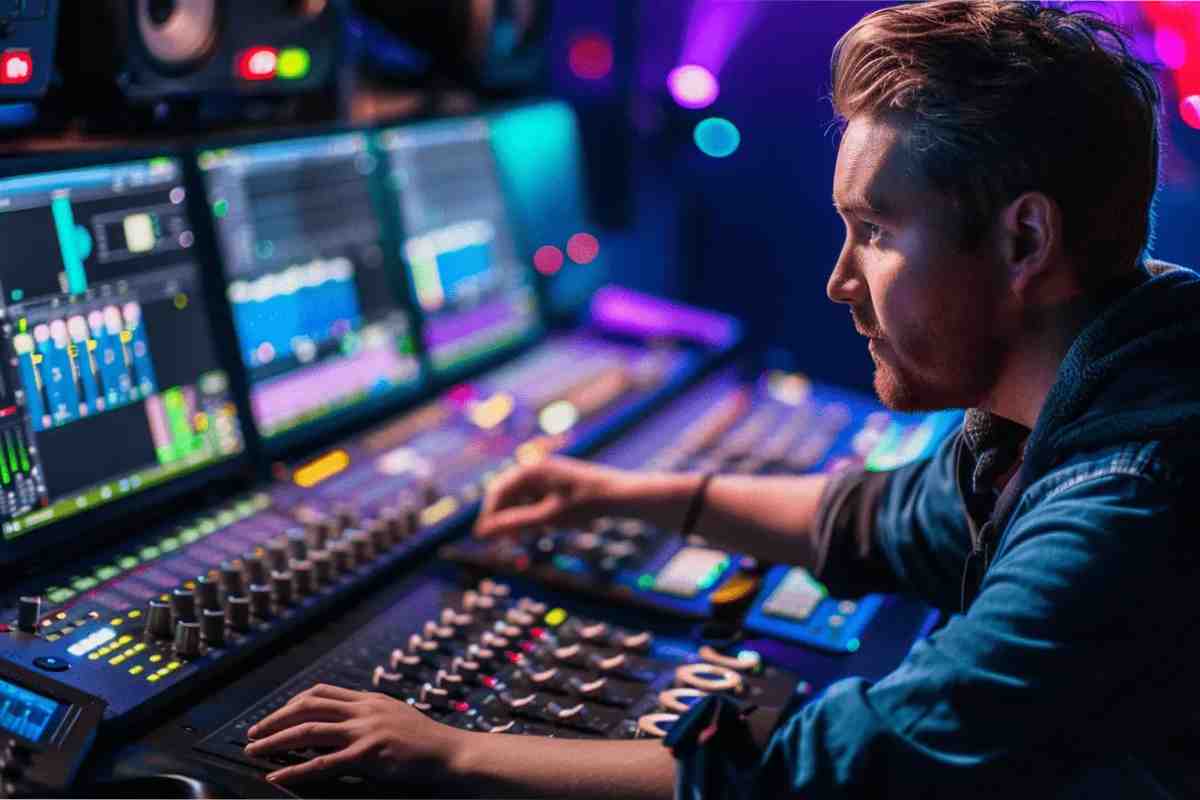About Voice Effects
What are voice effects? The term “voice effect” refers to any audio effect used in vocal production. The most common vocal effects tools are EQ, compressor, de-esser, reverb, delay, and saturation. These audio effects are essential mixing tools that come in handy in any genre.
What are Momentary Effects?

Momentary effects are only used for a short burst during a song.
The temporary use of products like delay or tremolo can add drama and dimension to specific moments in a piece. Likewise, the occasional touch of distortion or filtering can help add dynamics to some vocal productions.
Here are three current and creative vocal effects techniques that stand out.
1. Vocal Effects Automation
- Unless you’re working on a cappella project, your instruments will influence how you approach your vocal mix.
- Once you have your overall mix on sound footing, it’s time to consider the finer details of your arrangement.
- Are there places where the instrumental stops or fades? Should I increase the amount or duration of the reverb in the chorus?
- If you look closely, you’ll see that in modern vocal productions, there is a continual play between the wet and dry treatment of vocals; this is achieved through automation.
- This is the most pleasing way to control the temporary effects that help different vocal parts stand out in the mix.
- Take Selena Gomez’s single “Boyfriend,” for example. Can you hear her voice’s instantaneous reverb effects and low-pass filtered delay effects?
- Automating effect parameters like filter sweeps, delay, and reverb carefully and precisely takes time, but that will make your tracks stand out.
2. Use Pitch Correction Tools for Sound Design
- Most people use pitch alteration software to fix pitch problems in vocals.
- While some use pitch alteration to define their overall sound, many trap artists love the heavy use of autotune on their tracks.
- But between these two limits, there are many creative avenues to explore.
- Many vocal VSTs offer potent vocal processing that expands the voice to new levels of experimentation.
- Ultimately, you are responsible for how many pitch correction affects you. track use
- See how experimental pop artist Sevdaliza tackles her singing in her song “man Nature.”
- At times, her voice almost becomes a flute-like instrument thanks to her creative use of autotune.
3. Experiment with Formant Shift Voice Effects
- A formant is a feature of human vocalization that helps create the quality of spoken or sung vowels. Each format has a concentration of energy in a different frequency range that produces a different voice-like sound.
- Changing the formants can radically alter your perception of the voice. In addition, formant shifters are often used for gender or age-altering effects.
- A formant shift control plugin allows you to change how vowels are pronounced in a recording.
- When you turn it up to the maximum, the singer sounds like a caricature of a mosquito. If you turn it down, you’ll get a deal but a rich, thick vocal sound.
- Formant shifting as a creative effect has become increasingly popular recently.
- Formant shifting as a creative effect has become increasingly popular recently.
- Many producers use it in conjunction with pitch shifting and harmonizing effects.
- Some people change the format to mix the chorus parts better.
- Others use it to create artificial layers from the lead vocal performance. It is also helpful for those who need to add color to some improvised vocal parts in other ways.
- Alec King & Darnell’s “Bad Dreams” shows a very active and creative use of formant shifting as a vocal effect.
- The voices are continually dubbed and changed but still merge with the instrumental production.
- They make us wonder which parts represent “bad dreams” somehow. The connection between the vocal effects and the lyrics is incredible.
Below are Some Types of Voice Effects
1. Wide Voice Trick
When: For a subtle extension of vocals to add depth to the stereo spectrum.
How: Send the voice to a bus, and add a compressor and a stereo enhancer. Add stereo enhancement until the voice sounds bigger
2. Tape Slap
When: For a studio feel with live sound. It makes the vocals sound like they were recorded in an old-school studio with the instruments all around.
How: I use the Kramer Tape plugin and the slap/delay section to add it to the lead vocal without using it as a send. You can replicate this without the Kramer tape using a slap echo and analog saturation.
3. Extended ADT and Depth without Voice
When: Use this method when you want vocal depth without space. This makes the vocal more significant and present without adding a reverb tail that could mess up the mix.
How: Sends vocals at a stereo delay of 21 MS on the left and 29 MS on the right. Then use a pitch shifter to detune or raise your voice by about 10 cents. Finally, add the send below the main vocal track until you get your desired vibe. An advanced way to do this is with two entirely left and fully right-panned mono delays, with one pitch shifter detuning the voice by 10 cents while the other raises the vote by 10 cents.
4. Dissemination of Delays
When: Sometimes, you want to smooth out a delay and make delay repeats sound smoother.
How: Add a reverb afterward to the delay bus and a short delay for the reverb to dissipate any delay repeats.
5. The Importance of Pre Delay
When: Pre-delay can mark the reverb sound bigger without disturbing your vocals, delaying the effect by the number of milliseconds you choose.
How: Most reverbs have a pre-delay setting. Set the Pre-Delay to 20-40 MS to hear the reverb receding from the opening phrases of the voice.
6. Voice Comping for Perfect Doubles
When: Singers can’t always duplicate their takes perfectly. If you have the opportunity to edit, you can strengthen the vocal track by adjusting the phrases to match them exactly. This is particularly easy with modern, flexible time-processing tools. You end up with a perfect double instead of two vocal tracks that sound slightly out of sync.
How: It depends on what DAW and tools you have at your disposal, but the goal is to align the phrasing with the main vocal track.
7. Parallel Compression with EQ
When: If you want to keep the dynamics of the lead vocal track but add width and punch, you can add many compressors in parallel to get the finest of both worlds.
How: Send your voice to two different compressors, an 1176-FET-style and an LA2A Opto-compressor. Then mix the compressed vocals below as desired. Different compression styles handle vocals differently so you may want more of one than the other.
8. Sidechain Voice Effects
When: If you need a lot of space around vocals but don’t want to overload everything with reverb, you can sidechain the reverb and delay to avoid each other when the singer is singing.
How: I talked extensively about this technique in An Advanced Vocal Production Trick You Must Try.
9. The 100MS Delay Effect
When: This is another vocal effect that is more about adding depth than overloading the mix with too much reverb or delay repeats.
How: Add a 100-millisecond delay with a repeat. Add it under the voice. As simple as that
- Megaphone Effect
When: For that propaganda chant effect!
How: Use a high-pass filter and filter all lows and low-mids down to about 3-400 Hz. Add a low-pass filter and filter all highs down to 2-3 kHz. Find some ugly frequencies and amplify them. For an even more dramatic effect, add some soft saturation for grainy-sounding vocals. This works surprisingly well on Hard Rock as an effect.
Voice Effects are a Useful Tool in Your Creative Palette.
- Sure, not all mixes require vocal effects.
- Sometimes, a pop ballad with minimal instrumentation calls for a straightforward approach. If you’re a folk singer, you may want to protect the raw quality of your singing.
- But no matter what music you make, there’s always room for experimentation.
- The next time you’re mixing vocals, take some time to play with audio effects you don’t usually play with.
- Sometimes, something as simple as performing an impromptu vocal part through a wah-wah pedal can add that fun edge you’re looking for.
- Think of those times when you need to add sparkle and shine to your vocals.
- Imagine what could happen if you put a little shredder in your effects chain before a bright reverb.
- The key is to delight each vocal part with the same consideration and care as your instrumental productions.
Conclusion
Voice effects is important because it draws the audience in: it helps convey information, adds production value, evokes emotional responses, emphasizes what’s on screen, and is used to indicate mood. Using speech, sound effects, music, and even silence can dramatically improve your video. However, a lousy voice can ruin your video or animation. And yet, audio often remains an afterthought for post-production, which is crazy because no editing magic can fix the wrong voice.
Voice also can’t fix shoddy animation, sloppy editing, or amateurish camera work. Hence, audio is arguably more important than video quality when creating an immersive experience for your audience. Clay adds emotion and connects people with what they see. He supports each frame and cut, defining his narrative’s overall mood and tone.


